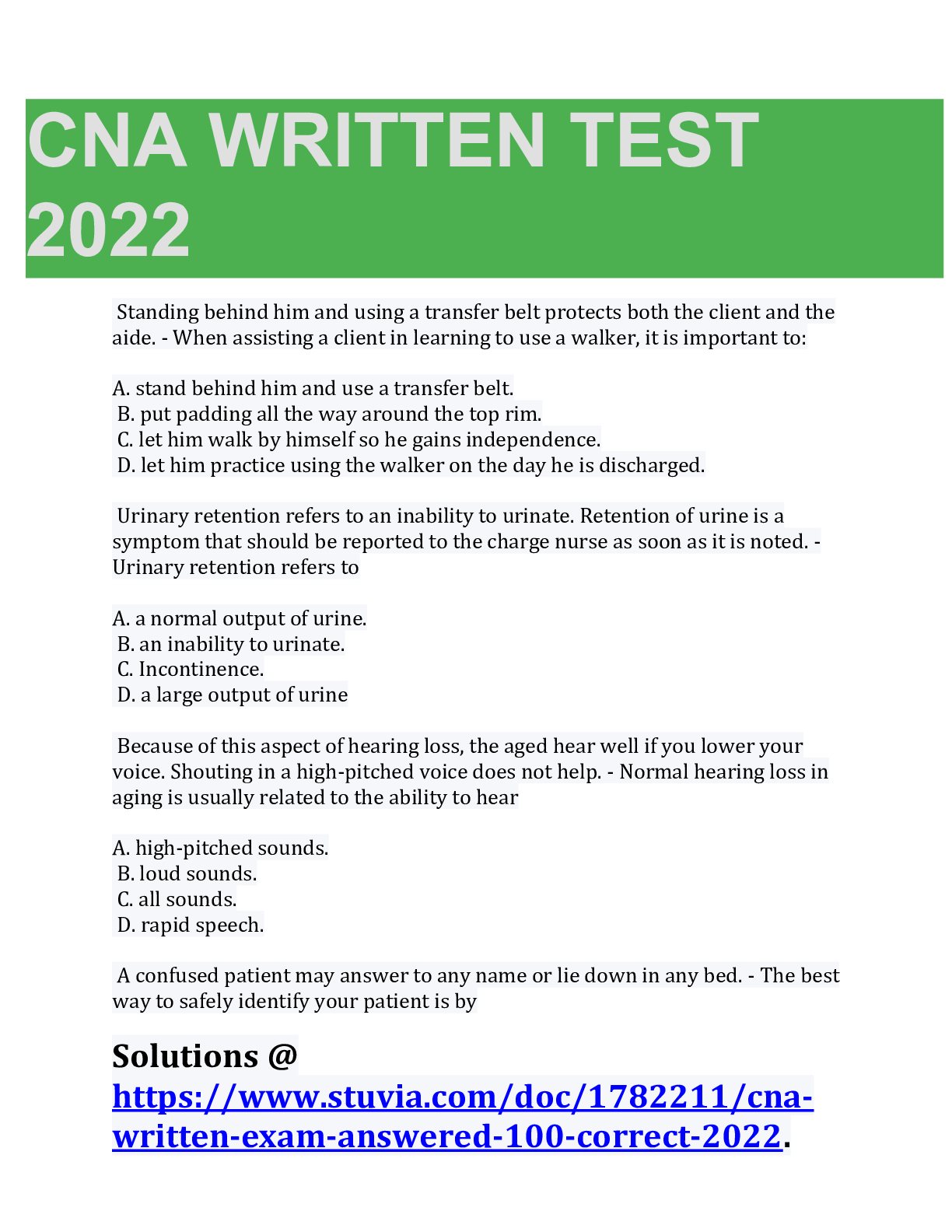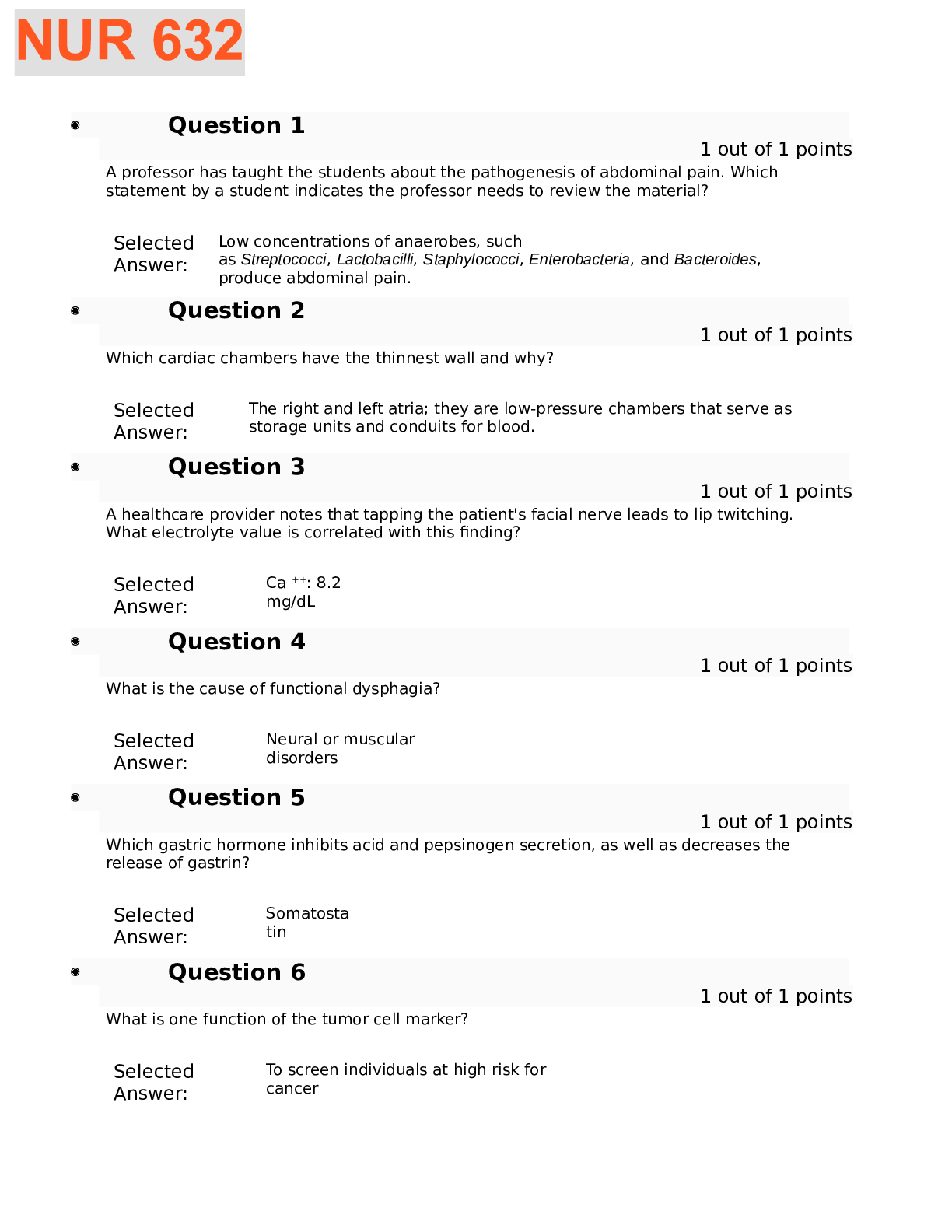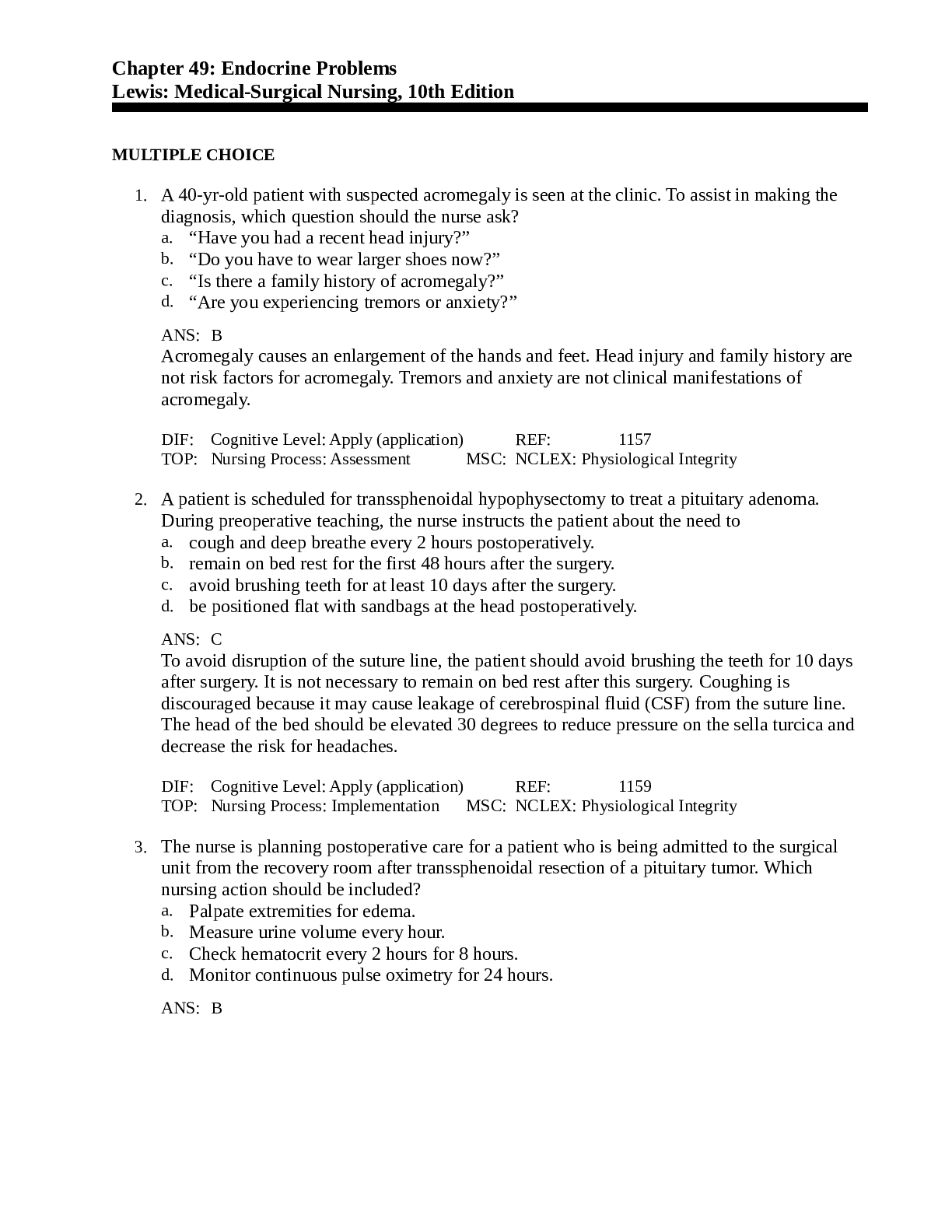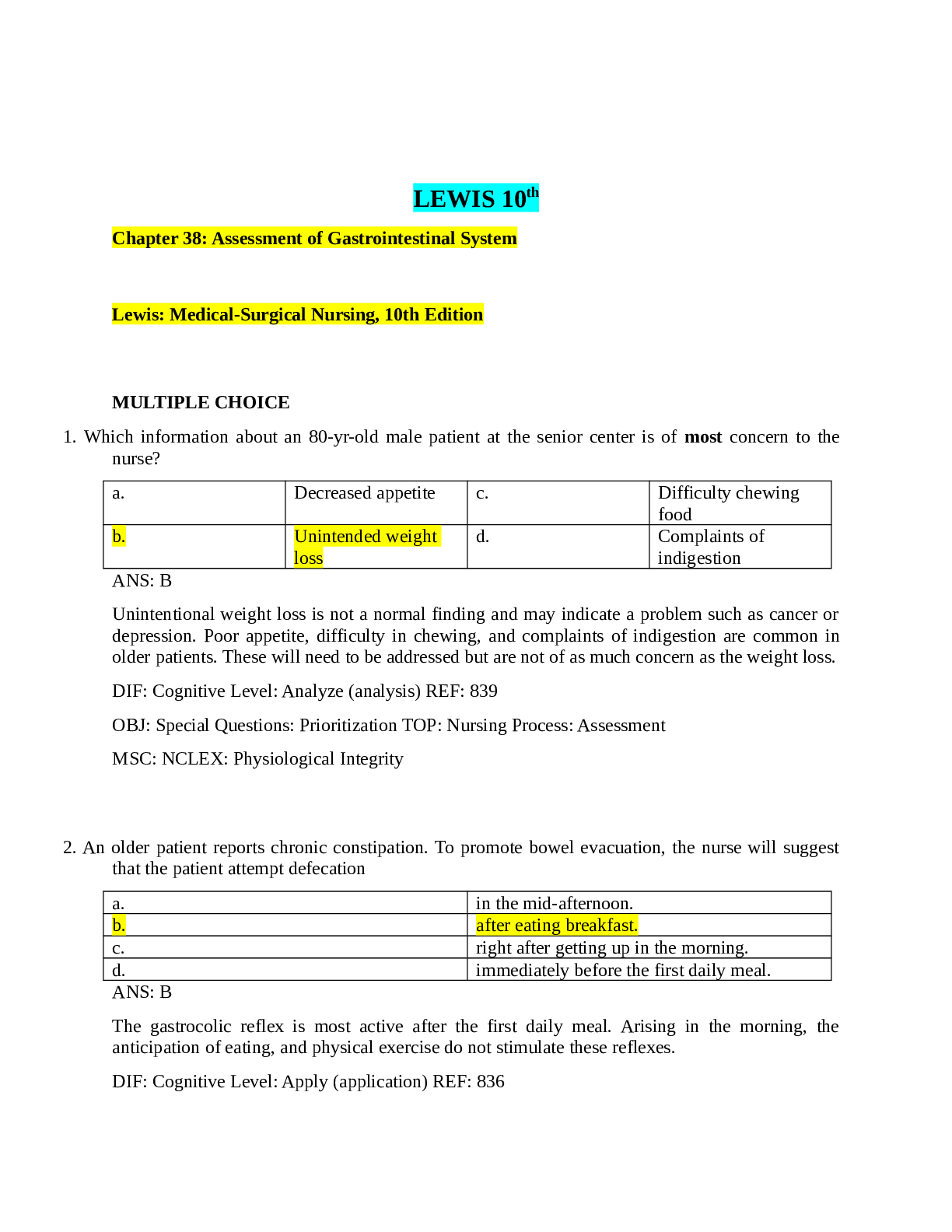*NURSING > QUESTIONS & ANSWERS > Test Bank Postoperative Care Lewis: Medical-Surgical Nursing, 10th Edition,100% CORRECT (All)
Test Bank Postoperative Care Lewis: Medical-Surgical Nursing, 10th Edition,100% CORRECT
Document Content and Description Below
On admission of a patient to the postanesthesia care unit (PACU), the blood pressure (BP) is 122/72. Thirty minutes after admission, the BP falls to 114/62, with a pulse of 74 and warm, dry skin. Whic... h action by the nurse is most appropriate? a. Increase the IV fluid rate. b. Continue to take vital signs every 15 minutes. c. Administer oxygen therapy at 100% per mask. d. Notify the anesthesia care provider (ACP) immediately. ANS: B A slight drop in postoperative BP with a normal pulse and warm, dry skin indicates normal response to the residual effects of anesthesia and requires only ongoing monitoring. Hypotension with tachycardia and/or cool, clammy skin would suggest hypovolemic or hemorrhagic shock and the need for notification of the ACP, increased fluids, and high-concentration oxygen administration In the postanesthesia care unit (PACU), a patient's vital signs are blood pressure 116/72, pulse 74, respirations 12, and SpO2 91%. The patient is sleepy but awakens easily. Which action should the nurse take first? a. Place the patient in a side-lying position. b. Encourage the patient to take deep breaths. c. Prepare to transfer the patient to a clinical unit. d. Increase the rate of the postoperative IV fluids. ANS: B The patient's borderline SpO2 and sleepiness indicate hypoventilation. The nurse should stimulate the patient and remind the patient to take deep breaths. Placing the patient in a lateral position is needed when the patient first arrives in the PACU and is unconscious. The stable blood pressure and pulse indicate that no changes in fluid intake are required. The patient is not fully awake and has a low SpO2, indicating that transfer from the PACU to a clinical unit is not appropriate An experienced nurse orients a new nurse to the postanesthesia care unit (PACU). Which action by the new nurse, if observed by the experienced nurse, indicates that the orientation was successful? a. The new nurse assists a nauseated patient to a supine position. b. The new nurse positions an unconscious patient supine with the head elevated. c. The new nurse turns an unconscious patient to the side upon arrival in the PACU. d. The new nurse places a patient in the Trendelenburg position when the blood pressure drops. ANS: C The patient should initially be positioned in the lateral "recovery" position to keep the airway open and avoid aspiration. The Trendelenburg position is avoided because it increases the work of breathing. The patient is placed supine with the head elevated after regaining consciousness An older patient is being discharged from the ambulatory surgical unit following left eye surgery. The patient tells the nurse, "I do not know if I can take care of myself with this patch over my eye." Which action by the nurse is most appropriate? a. Refer the patient for home health care services. b. Discuss the specific concerns regarding self-care. c. Give the patient written instructions regarding care. d. Assess the patient's support system for care at home. ANS: B The nurse's initial action should be to assess exactly the patient's concerns about self-care. Referral to home health care and assessment of the patient's support system may be appropriate actions but will be based on further assessment of the patient's concerns. Written instructions should be given to the patient, but these are unlikely to address the patient's stated concern about self-care The nasogastric (NG) tube is removed on the second postoperative day, and the patient is placed on a clear liquid diet. Four hours later, the patient complains of sharp, cramping gas pains. What action by the nurse is the most appropriate? a. Reinsert the NG tube. b. Give the PRN IV opioid. c. Assist the patient to ambulate. d. Place the patient on NPO status. ANS: C Ambulation encourages peristalsis and the passing of flatus, which will relieve the patient's discomfort. If distention persists, the patient may need to be placed on NPO status, but usually this is not necessary. Morphine administration will further decrease intestinal motility. Gas pains are usually caused by trapping of flatus in the colon, and reinsertion of the NG tube will not relieve the pains A patient's T-tube is draining dark green fluid after gallbladder surgery. What action by the nurse is the most appropriate? a. Notify the patient's surgeon. b. Place the patient on bed rest. c. Document the color and amount of drainage. d. Irrigate the T-tube with sterile normal saline. ANS: C A T-tube normally drains dark green to bright yellow drainage, so no action other than to document the amount and color of the drainage is needed. The other actions are not necessary Which action by the nurse will be most helpful to a patient who is expected to ambulate, deep breathe, and cough on the first postoperative day? a. Schedule the activity to begin after the patient has taken a nap. b. Administer prescribed analgesic medications before the activities. c. Ask the patient to state two possible complications of immobility. d. Encourage the patient to state the purpose of splinting the incision. ANS: B An important nursing action to encourage these postoperative activities is administration of adequate analgesia to allow the patient to accomplish the activities with minimal pain. Even with motivation provided by proper teaching, positive reinforcement, concern about complications, and with rest and sleep, patients will have difficulty if there is a great deal of pain involved with these activities. A nurse assists a patient on the first postoperative day to ambulate, cough, deep breathe, and turn. Which action by the nurse is most helpful? a. Teach the patient to fully exhale into the incentive spirometer. b. Administer ordered analgesic medications before these activities. c. Ask the patient to state two possible complications of immobility. d. Encourage the patient to state the purpose of splinting the incision. ANS: B An important nursing action to encourage these postoperative activities is administration of adequate analgesia to allow the patient to accomplish the activities with minimal pain. Even with motivation provided by proper teaching, positive reinforcement, and concern about complications, patients will have difficulty if there is a great deal of pain involved with these activities. When using an incentive spirometer, the patient should be taught to inhale deeply, rather than exhale into the spirometer to promote lung expansion and prevent atelectasis [Show More]
Last updated: 2 years ago
Preview 1 out of 6 pages

Buy this document to get the full access instantly
Instant Download Access after purchase
Buy NowInstant download
We Accept:

Reviews( 0 )
$15.00
Can't find what you want? Try our AI powered Search
Document information
Connected school, study & course
About the document
Uploaded On
Oct 07, 2022
Number of pages
6
Written in
Additional information
This document has been written for:
Uploaded
Oct 07, 2022
Downloads
0
Views
39








.png)




 Correct Study Guide, Download to Score A.png)
 Correct Study Guide, Download to Score A.png)
 Correct Study Guide, Download to Score A.png)
 Correct Study Guide, Download to Score A.png)
 Correct Study Guide, Download to Score A.png)
 Correct Study Guide, Download to Score A.png)
 Correct Study Guide, Download to Score A.png)
 Correct Study Guide, Download to Score A.png)

